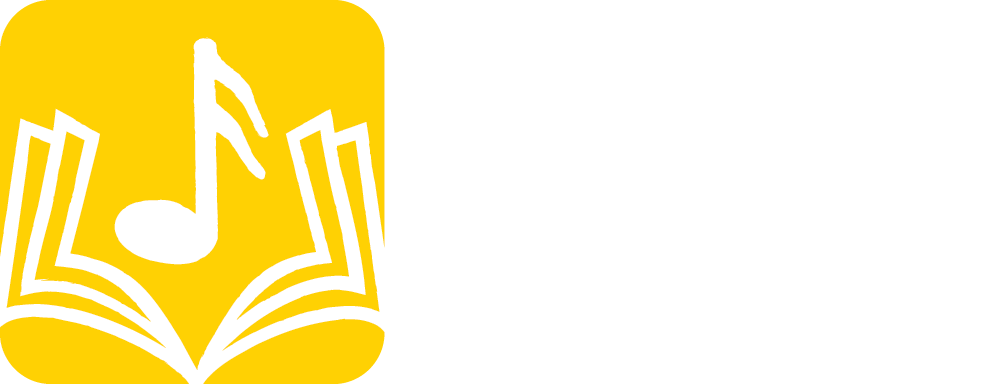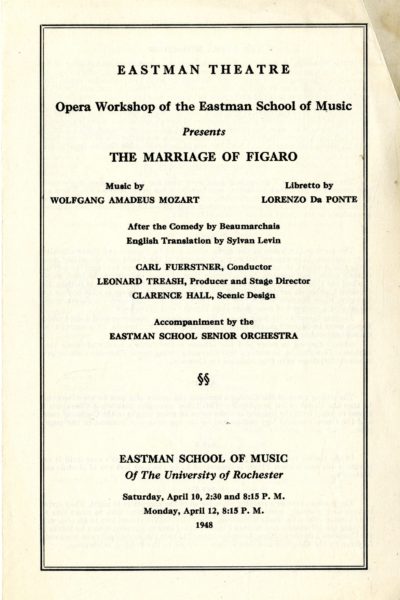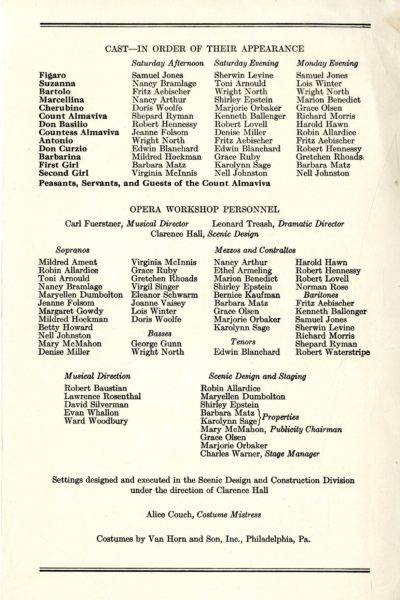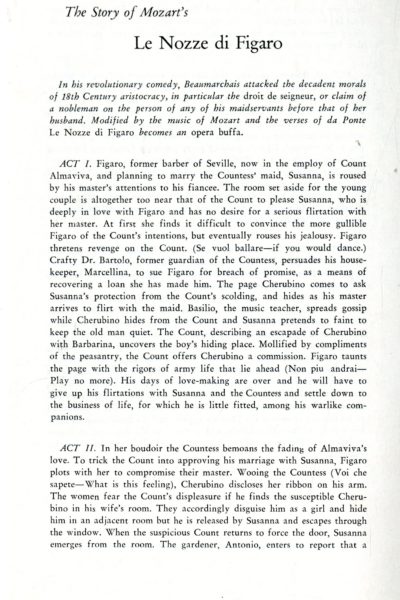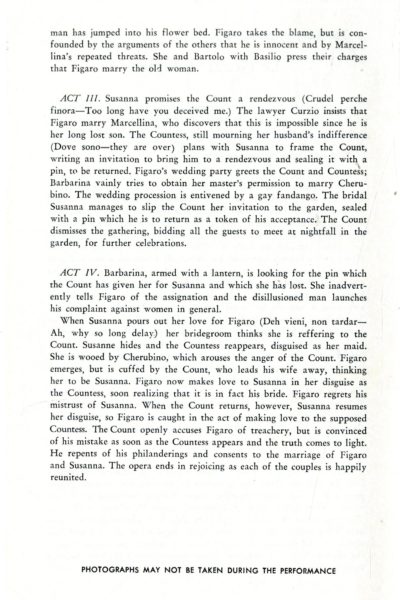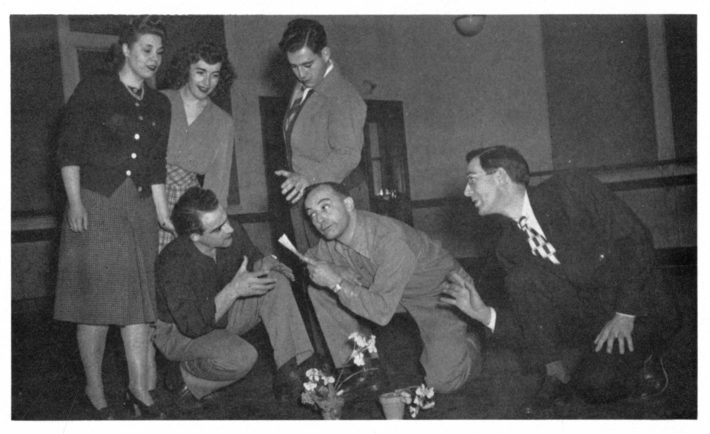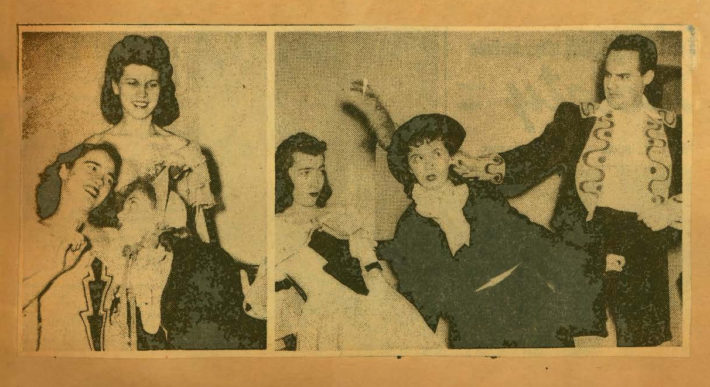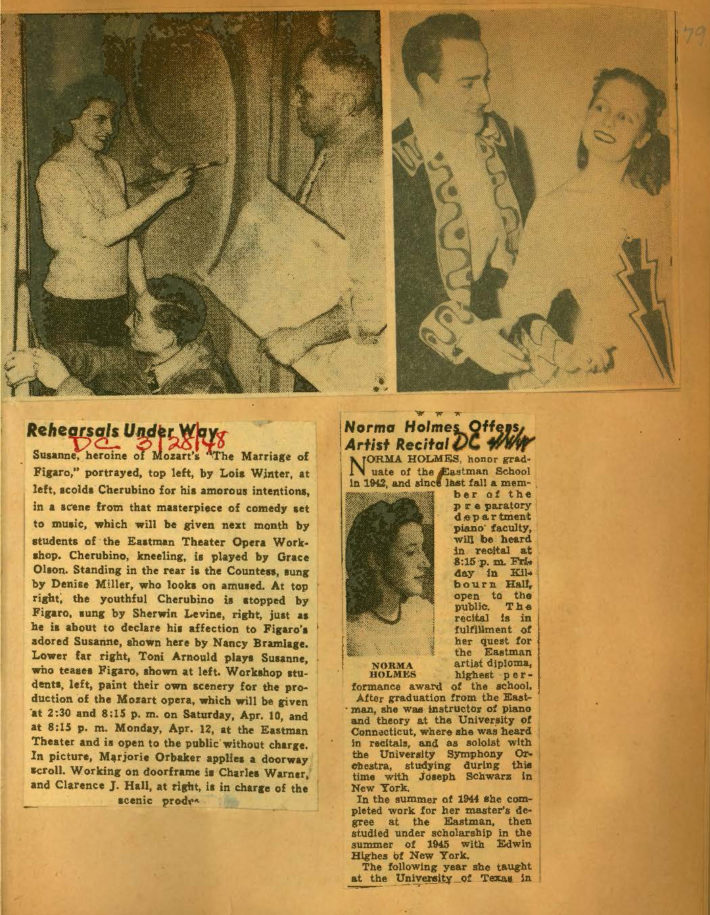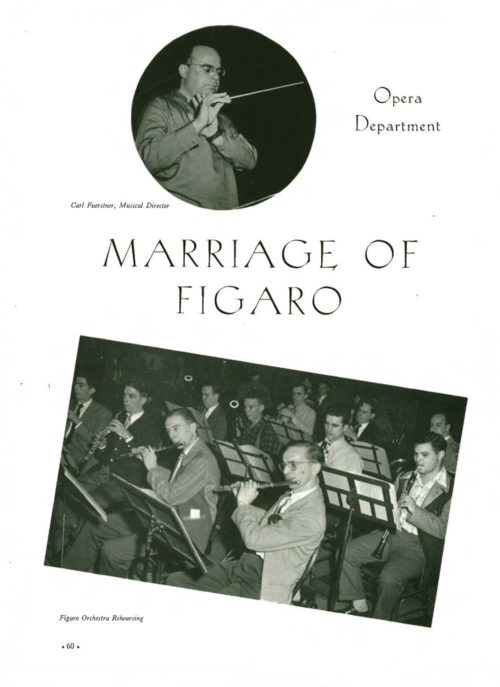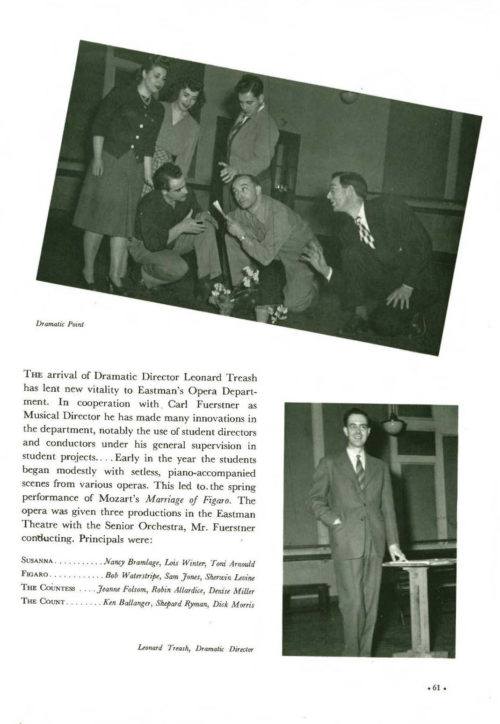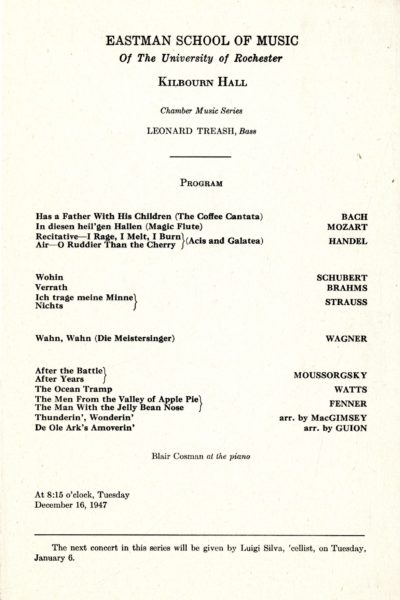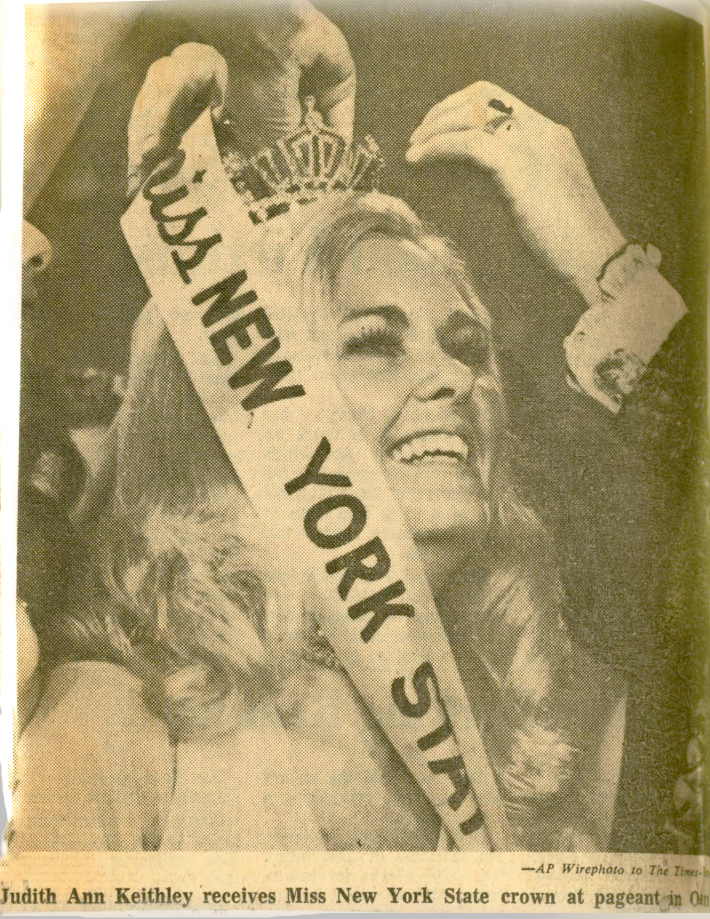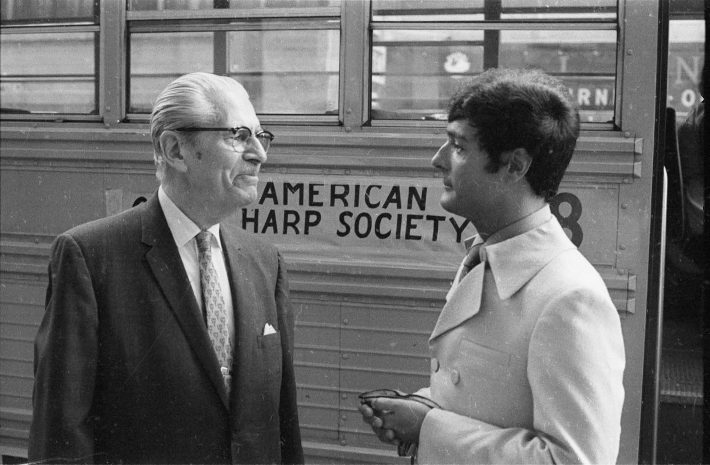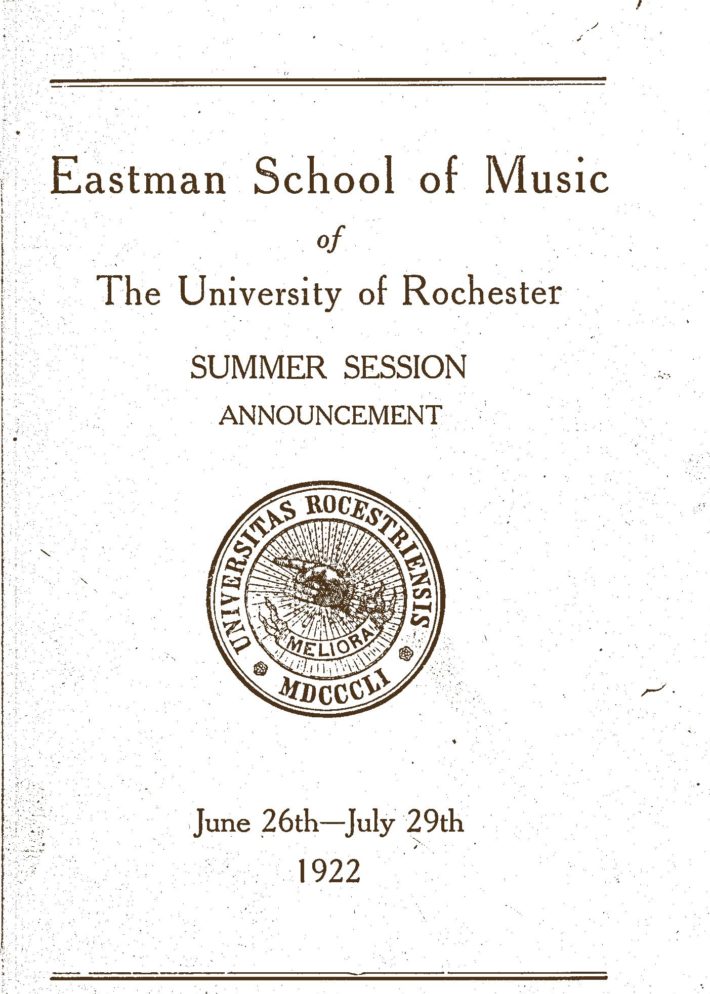1948: Milestone production of The Marriage of Figaro
Seventy-five years ago this week, on April 10th and 12th, 1948, Mozart’s beloved comic opera The Marriage of Figaro was staged in Kilbourn Hall, marking the Eastman School’s first complete production of this opera. The production actually constituted a dual milestone, for not only was it Eastman’s first complete experience with Figaro, but it also marked the Eastman directorial debut by newly appointed Dramatic Director Leonard Treash,[1] who had spent the academic year introducing numerous innovations into operatic training at Eastman.
► Printed program for the Eastman School’s 1948 production of The Marriage of Figaro. Director Treash’s own copy of the program included this two-page insert outlining in detail the opera’s action, but it’s unclear as to whether the Concert Office provided this insert generally to the entire audience.
The Marriage of Figaro, Mozart’s beloved comic opera based on the play of the same title by French playwright Pierre Augustin Caron de Beaumarchais (1732-1799), requires no introduction. One of the most beloved and most frequently performed works in the operatic literature, it is readily accessible as a performance vehicle for university and college forces. Further, with its abundant hilarity derived from its humorous and gently satiric treatment of the social order of its day, the story boasts immediate audience appeal; paired with Mozart’s immortal music, this opera is a certain guarantee of an enjoyable evening or matinée. Although there had been to date no complete production at Eastman, the Opera Department’s legacy of Mozart performances during the school’s first quarter century (1921-1946) was nevertheless substantive. Besides frequent presentations of scenes from Mozart operas each semester,[2] four Mozart operas had been staged in their entirety, together with selected acts from two others. Don Giovanni, opera buffa in two acts, was staged in Kilbourn Hall (with orchestra) in 1929. Bastien and Bastienne, an early Singspiel in one act, was staged in Kilbourn Hall (with orchestra) in 1931 on a double bill with Donizetti’s Il Campanello (The Night-bell), and was staged again in 1942 on a double bill with Jules Offenbach’s The Enchanted Fife. The Disguised Gardener (La finta giardiniera), opera buffa in three acts, was staged in Kilbourn Hall in 1939 on a double bill with The Deceived Kadi by Gluck. The Impresario (Der Schauspieldirector), comic Singspiel in one act, was staged in Kilbourn Hall (with orchestra) in 1946 on a double bill with Solomon and Balkis (The Butterfly that Stamped) by Randall Thompson. The Impresario was repeated that same semester, in May, 1946, on a double bill with act I of Richard Wagner’s The Flying Dutchman. Besides these four operas, Eastman also enjoyed the first act of Cosi fan tutte, staged in Kilbourn Hall in 1939 on a double bill with Pergolesi’s Serva Padrona (The Maid Mistress), and on two separate occasions, selected acts from The Marriage of Figaro: act II in 1941 on a double bill with Gilbert and Sullivan’s Cox and Box; and act I in 1944 (with orchestra) on a double bill with scenes from Gluck’s Orfeo.
These brief items in the Rochester press gave publicity to the Eastman production of Figaro. Together with the Eastman School’s 1948 yearbook, the press items represent the only extant photographs from this production.
Leonard Treash considered The Marriage of Figaro an ideal instructional piece, as noted in comments (presumably his own) that were printed in the 1948 program. So as to maximize the shared experience of as many students as possible, Eastman’s 1948 production was triple-cast for three performances, each with an independent cast, although a few selected singers reprised their roles in more than one performance. Musical accompaniment for the production was provided by the Eastman School Senior Orchestra, conducted by Carl Fuerstner.[3] The principals in the three casts were the following students:
Nancy Bramlage (Susanna) [later Mrs. Nancy Ewing], BM ‘50
Lois Winter (Susanna), BM ’48, PC ’49, MAS ‘50
Antoinette Arnould (Susanna) [later Mrs. Toni Foglesong], BA ’48, PC ‘49
Robert Waterstripe (Figaro), BM ’49, MAS ‘50
Samuel Jones, Jr. (Figaro), BM ’50
Sherwin Levine (Figaro), BM ‘50
Jeanne Folsom (The Countess) [later Mrs. Jeanne Pavlock], BM ‘47
Jessie R. (Robin) Allardice (The Countess), BM ’48, PC ‘49
Denise Miller (The Countess) [later Mrs. Denise Apel], BM ’47 piano
Ken Ballenger (The Count), MM ‘48
Shepard Ryman (The Count), BM ‘49
Dick Morris (The Count), enrolled only in 1947-48
A survey of the later careers of the cast members of Eastman’s 1948 Figaro indicates that many went on to academic life, some of them eventually attaining emeritus status at their institutions. At least one became a professional orchestral conductor, and numerous others became private music teachers. Some left musical circles altogether and entered the business world, and one enjoyed a career at Newsweek.
► This two-page spread profiled the 1948 production of The Marriage of Figaro in the Eastman School’s 1948 yearbook. Note that the feature appropriately recognized newly appointed Dramatic Director Leonard Treash.
In keeping with standard practice at the Eastman School, the 1948 production of Figaro was recorded. Each of the three performances was captured on 16” instantaneous discs, and the analog content was later re-formatted to preservation tape during extensive preservation work that commenced in the late 1980s. The extant photographic evidence of the performance is limited to the few images that were published in the Eastman School’s yearbook and in the Rochester press, all of which content is displayed here. As of this writing in 2023, there have been 11 productions of Figaro at Eastman; the most recent was in April, 2016.
The 1947 appointment of Leonard Treash ushered in a new era of operatic training and production at the Eastman School. After Vladimir Rosing, founder of the Opera Department, had left the Eastman School’s employ in 1926, the department had been re-structured to be conducted along the lines of an academic department at the dictates of Director Howard Hanson. In 1947, amidst the tremendous social changes that followed World War II and a re-evaluation of American strength in all cultural and artistic realms both at home and abroad, the Eastman School embarked on a new method in opera. Mr. Treash’s most significant contribution was the introduction of the Opera Workshop as the center of activity. A brief summary of the Opera Workshop’s philosophy (almost certainly written by Mr. Treash) was printed in the program of the 1948 Figaro production. That statement articulated the goal that the performers would “. . . learn to synchronize action with music of high dramatic content in almost every type of ensemble and solo form.” Further, the Opera Workshop would provide training for performers “. . .which will help to fit them for a new era in opera in this country, either as singers, technicians, or perhaps more enthusiastic and intelligent listeners and patrons.” Ultimately, the Opera Workshop would strengthen efforts to enable opera “to reach the masses and become good entertainment” and to make opera “. . .intelligible with emphasis upon the perfection of the ensemble, both in acting and singing, and with the use of understandable English translations.”
The Eastman School’s published annual catalogues make clear the distinction between the previous approach and the Opera Workshop. The 1945-46 annual catalogue defined the curriculum for a Major in Voice with Minor with Oratorio and Opera as a program of study in which voice students would, in their junior and senior years, divide their time equally between opera and oratorio. Apart from the requisite instruction in English Diction and French Diction, the operatic-intensive component of the curriculum was comprised, in the junior and senior years, of courses in Dramatics for four semesters, together with the course Coaching in Roles, Song Literature, and Oratorio. Following the appointment of Mr. Treash, however, there was a new approach. The 1949-50 annual catalogue still defined the Major in Voice as having a Minor in Opera and Oratorio, but in both the junior and senior years, the degree candidate would now elect the Opera Workshop for six hours per week each semester, amounting to two units per semester. The annual catalogue promoted the Opera Workshop as “an integrated course based upon the idea that opera is an all-inclusive art embracing music, drama, design, and the crafts. It provides stimulation and practice for potential musical and stage directors, designers, and craftsmen, as well as for singing actors.” Further, the annual catalogue promoted that within the Opera Workshop, the students would perform every task concerned with opera presentation. Those tasks were defined as including body movement and facial and emotional expression; conducting; and set design, from sketches through isometric drawings and scale models to actual construction of sets for full production under the supervision of the scenic design director. The prospective student was advised that “by the end of the course. . . he [sic] should be well equipped to become a figure for the cause of Opera in America, either as a singing actor, a musical or stage director, a technician, or as a more intelligent and enthusiastic patron.”
Essentially, all of this underscored the philosophy that had been promoted by Opera Department founder Vladimir Rosing, who had stressed the need a truly holistic training in the art and craft of opera.[4] One visible manifestation of the shift was on display to audience members by way of the printed programs. Whereas the programs had previously announced “The Opera Department presents. . .”, from 1947 onwards the programs announced “The Opera Workshop presents . . ..”[5]
At the upper administrative level, Director Howard Hanson singled out Mr. Treash’s work in his Annual Report to the President of the University for academic year 1947-48. Hanson was normally loquacious in any of his speaking and writing, and certainly in his annual reports to the President of the University, he was inclined to provide copious details with free-flowing accompanying prose descriptions. By contrast, in his 1947-48 report to Dr. Alan Valentine, Hanson dispensed with a recitation of the achievements of each of the Eastman School’s academic departments in favor of singling out Leonard Treash and the Opera Workshop exclusively:
“This report would reach to an inordinate length if an account were given of the accomplishments of each department. It is not inappropriate, however, to speak of the splendid work of the newly organized opera department under its new dramatic director, Leonard Treash, and its musical director, Carl Fuerstner. This departmental has been re-organized as an operatic workshop in which the students learn the entire technic [sic] of stage presentation from the designing and building of stage sets to dramatic and musical direction. The three delightful performances of Mozart’s Marriage of Figaro with three independent casts pointed up admirably both the quantity and quality of work being accomplished.”[6]
Already at the mid-point of the fall semester in 1947, Director Treash had put the results of the Opera Workshop’s work on display with a showcase of scenes in Kilbourn Hall. Formally promoted as The Opera Workshop presents A Demonstration of the Work of the First Six Weeks (program displayed here), it featured student performers in scenes from eight operas, ranging chronologically from Mozart to Menotti. Significantly, one aspect of the new method was prominently on view on the printed program: each of the dramatic directors and musical directors cited on the program were enrolled students. Here was another of Mr. Treash’s innovations, to train students in direction by empowering them to assume the directorial roles themselves.
Finally, the commitment to staging new works was a continuing dynamic under Leonard Treash. Since the 1920s and ‘30s the Opera Department had been staging new works by American composers in parallel with the American music initiatives launched by Howard Hanson; the Opera Workshop continued in that commitment with force. Future entries of “This Week at Eastman” will feature some of those productions during the observance of Eastman Opera’s centennial (2023-24).
In the meantime, apart from his work with the Opera Workshop, Mr. Treash was a faculty member in voice, charged with teaching degree candidates and performing the required annual faculty artist recital, just as dramatic director Nicholas Konraty had been before him. One month after the Demonstration of the Work of the First Six Weeks cited above, Mr. Treash gave a faculty recital in Kilbourn Hall (program displayed here), and in the following semester, two of his students performed their graduation recitals.
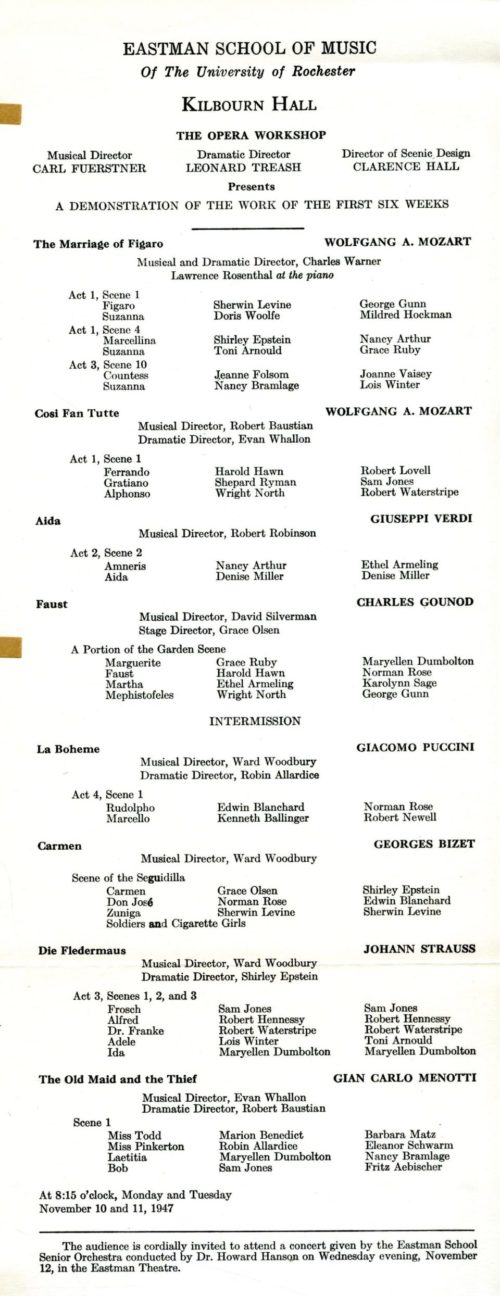
[1] Leonard Treash (1909-1996), baritone and graduate of the College-Conservatory of Music at the University of Cincinnati, served on the Eastman School faculty 1947-76. He had been preceded as dramatic director by Nicholas Konraty (served in that capacity 1929-47), and would be succeeded by Richard Pearlman (served 1976-95). A collection of Mr. Treash’s professional papers resides at the Ruth T. Watanabe Special Collections in the Sibley Music Library.
[2] During the Eastman School’s early decades, the Concert Office routinely printed programs for the presentation of scenes, usually performed in Kilbourn Hall. In the school’s first quarter century, scenes from Mozart operas were performed in May, 1926; December, 1926; December, 1927; June, 1931; January, 1939; and, March, 1947.
[3] Carl Fuerstner, conductor and pianist, served on the Eastman School faculty 1945-50. He was the designated musical director of opera during those years.
[4] Mr. Rosing’s philosophy included an additional dramatic aspect which he energetically promoted: the concept of opéra intime, a method of staging and performing opera using reduced forces and minimal stage settings, thereby enabling presentation in smaller or otherwise unaccustomed venues.
[5] In 1976, with the appointment of Artistic Director Richard Pearlman, the nomenclature was changed again, this time to Eastman Opera Theater, by which the Eastman School’s operatic endeavors continue to be known.
[6] Annual Report on the Eastman School of Music to Dr. Alan Valentine, President of the University of Rochester, 1947-48, signed by Howard Hanson, May 10, 1948. Typescript carbon copy in the Howard Hanson Collection, accession no. 2005/3/25, box 54, folder 26.
